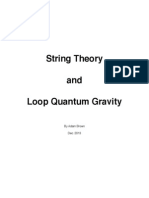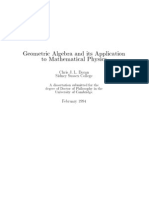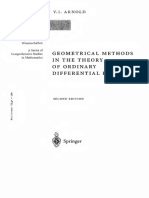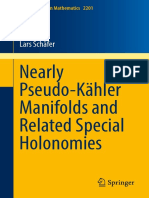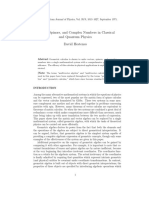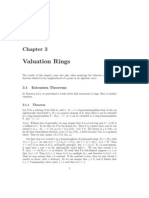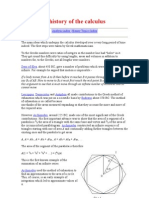Introduction To Hyperreal Numbers
Uploaded by
olympicus47Introduction To Hyperreal Numbers
Uploaded by
olympicus47Introduction to
the HyperReals
An extension of the Reals
with infinitely small and
infinitely large numbers.
Introduction to the
HyperReals
Descriptive introduction
Pictures of the HyperReals
Axioms for the HyperReals
Some Properties (Theorems) of
HyperReals
Descriptive introduction
A complete ordered field extension of the
Reals
(in a similar way that the Reals is a complete
ordered field extension of the Rationals)
Contains infinitely small numbers
Contains infinitely large numbers
Has the same logical properties as the
Reals
The HyperReals
Near the Reals
The HyperReals
Far from the Reals
Axioms for the HyperReals
Axioms common to the Reals
Algebraic Axioms
Order Axioms
Completeness Axiom
Axioms unique to the HyperReals
Extension Axiom
Transfer Axiom
Algebraic Axioms
Closure laws: 0 and 1 are numbers. If a and b are
numbers then so are a+b and ab.
Commutative laws: a + b = b + a and ab = ba
Associative laws: a + (b + c) = (a + b) +c and
a(bc)=(ab)c
Identity laws: 0 + a = a and 1a = a
Inverse laws:
For all a, there exists number a such that a + (-a) = 0 and
if a 0, then there exist number a
-1
such that a(a
-1
) = 1
Distributive law: a( b+c ) = ab + ac
Order Axioms
The is a set P of positive numbers which satisfies:
If x, y are elements of P then x + y is an element of P.
If x, y are elements of P then xy is an element of P.
If x is a number then exactly one of the following must
hold:
x = 0,
x is an element of P or
-x is an element of P.
Definition of < and >
a < b
if and only if
(b - a) is an element of P
i.e. (b - a) is positive
a > b if and only if b < a
Properties of <
0 < 1
Transitive law:
If a<b and b<c then a<c.
Trichotomy law:
Exactly one of the relations a<b, a = b, b<a, holds.
Sum law:
If a<b, then a+c<b+c.
Product law:
If a<b and 0<c, then ac<bc.
Root law:
For a>0 and positive integer n,
there is a number b>0 such that b
n
= a.
Completeness Axiom
A number b is said to be an upper bound of a
set of numbers A if b > x for all x in A.
A number c is said to be an least upper bound
of the set of numbers A if c is an upper bound
of A and b > c for all upper bounds b of A.
Completeness Axiom:
Every non-empty set of numbers which is
bounded above has a least upper bound.
Axioms unique to the
HyperReals
Extension Axiom
Transfer Axiom
Note: Actually these axioms are all that are
needed as for the HyperReals as the previous
axioms can be derived from these two axioms.
Extension Axiom
The set R of real numbers is a subset of the set R* of
hyperreal numbers.
The order relation <* on R* is an extension of the
order < on R.
There is a hyperreal number such that 0 <*
and <* r for each positive real number r.
For each real function f there is a given hyperreal
function f* which has the following properties
domain(f) = R domain(f*)
f(x) = f*(x) for all x in domain(f)
range(f) = R range(f*)
(Extension actually applies to any standard set built from the Reals.)
Transfer Axiom
(Function version)
Every real statement that holds for one or more particular
real functions holds for the hyperreal extensions of
these functions
(Full version)
Every standard statement (about sets built from the Reals)
is true if and only if the corresponding non-standard
statement (about sets built from HyperReals - formed by
adding the * operator) is true.
Example: Deriving the Commutative Laws
from the Extension and Transfer Axioms
Commutative laws for the Reals:
S: aeR beR a+b=b+a and ab=ba.
The Extension axiom gives us R*, +*, *, and e* and
the Transfer axiom tells us that S*, the commutative
laws for the HyperReals is true.
Commutative laws for the HyperReals:
S*: ae*R* be*R* a+*b=b+*a and a*b=b*a.
Definition: Infinitesimal
A HyperReal number b is said to be:
positive infinitesimal if b is positive but
less than every positive real number.
negative infinitesimal if b is negative but
greater than every negative real number.
infinitesimal if b is either positive
infinitesimal, negative infinitesimal, or 0.
Definitions:
Finite and Infinite
A HyperReal number b is said to be:
finite if b is between two real numbers.
positive infinite if b is greater than every
real number.
negative infinite if b is smaller than every
real number.
infinite if b is positive infinite or negative
infinite.
Theorem:
The only real infinitesimal number is 0.
Proof:
Suppose s is real and infinitesimal.
Then exactly one of the following is true:
s is negative, s = 0, or s is positive.
If s is negative then it is a negative infinitesimal and hence
r < s for all negative real numbers r. Since s is negative
real then s < s which is nonsense.
Thus s is not negative.
Likewise if s is positive we get s < s. So s is not positive.
Hence s = 0.
The Standard Part Principle
Theorem:
For every finite HyperReal number b, there is
exactly one real number r infinitely close to b.
Definition:
If b is finite then the real number r, with r b, is
called the standard part of b.
We write r = std( b ).
Proof of the Standard Part Principle
Uniqueness:
Suppose r, s c R and r ~ b and s ~ b.
Hence r ~ s.
We have r-s is infinitesimal and real.
The only real infinitesimal number is 0.
Thus r-s = 0 which implies r = s.
Existence:
Since b is finite there are real numbers s and t with s < b < t.
Let A = { x | x is real and x < b }. A is non-empty since it contains s
and is bounded above by t. Thus there is a real number r which is
the least upper bound of A.
We claim r ~ b.
Suppose not. Thus r = b and Hence r-b is positive or negative.
Case r-b is positive. Since r-b is not a positive infinitesimal there is a
positive real s, s < r-b which implies b < r-s so that r-s is an upper
bound of A. Thus r-s > r but r-s < r. Thus r-b is not positive.
Case r-b is negative. Since r-b is not a negative infinitesimal there is a
negative real s, r-b<s which implies r-s < b so r-s is in A and
hence r > r-s but r < r-s, since s<0.
Thus r-b is infinitesimal. So r ~ b.
Infinite Numbers Exist
Let be a positive infinitesimal.
Thus 0 < < r for all positive real number r.
Let r be a positive real number. Then so is 1/r.
Therefore 0 < < 1/r and so 1/ > r.
Let H = 1/ . Thus H > r for all positive real
number r.
Therefore H is an infinite number.
General Approach to Using
the HyperReals
Start with standard (Real) problem
Extend to non-standard (HyperReal) - adding *
Find solution of non-standard problem
Take standard part of solution to yield standard
solution - removing *
Note: In practice we normally switch between
Real and HyperReal without comment.
Theorem 1: Rules for Infinitesimal,
Finite, and Infinite Numbers
Th. Assume that c and o are infinitesimals; b,c
are hyperreal numbers which are finite but
not infinitesimal; and H, K are infinite
hyperreal numbers; and n an integer . Then
Negatives:
-c is infinitesimal.
-b is finite but not infinitesimal.
-H is infinite.
(Theorem cont)
Reciprocals:
1/c is infinite.
1/b is finite but not infinitesimal.
1/H is infinitesimal.
Sums:
c +o is infinitesimal.
b+c is finite but not infinitesimal.
b+c is finite (possibly infinitesimal).
H+c and H+b are infinite.
(Theorem cont)
Products:
c-o and c-b are infinitesimal
b*c is finite but not infinitesimal.
H *b and H*K are infinite.
Roots:
If c >0, is infinitesimal.
If b>0, is finite but not infinitesimal.
If H>0, is infinite.
n
c
n
b
n
H
(Theorem cont)
Quotients:
c/ b, c/ H, and b/ H are infinitesimal
b/c is finite but not infinitesimal.
b/c , H/c, and H/b are infinite provided
0. c =
Indeterminate Forms
Indetermina
te Form
infinitesimal finite
(equal to 1)
infinite
c/o c
2
/c
c/c c/c
2
H/K H/H
2
H/H H
2
/H
H*c H*(1/H
2
) H*(1/H) H
2
*(1/H)
H+K H+(-H)
(H+1)+(-H)
H+H
Examples
Theorem 2
1. Every hyperreal number which is between two
infinitesimals is infinitesimal.
2. Every hyperreal number which is between two
finite hyperreal numbers is finite.
3. Every hyperreal number which is greater than
some positive infinite number is positive
infinite.
4. Every hyperreal number which is less than
some negative infinite number is negative
infinite.
Definitions:
Infinitely Close
Two numbers x and y are said to be
infinitely close ( written x ~ y) if and only
(x-y) is infinitesimal.
Theorem 3.
Let a, b, and c be hyperreal numbers. Then
1. a ~ a
2. If a ~ b, then b ~ a
3. If a ~ b and b ~ c then a ~ b.
(i.e., ~ is an equivalence relation.)
Theorem 4.
Assume a ~ b, Then
1. If a is infinitesimal, so is b.
2. If a is finite, so is b.
3. If a is infinite, so is b.
Definition: Standard Part
Let b be a finite hyperreal number.
The standard part of b, denoted by
st(b), is the real number which is
infinitely close to b.
Note this means:
1. st(b) is a real number
2. b = st(b) + c for some infinitesimal c.
3. If b is real then st(b) =b.
Theorem 5.
Let a and b be finite hyperreal numbers.
Then
1. st(-a) = -st(a).
2. st(a+b) = st(a) + st(b).
3. st(a-b) = st(a) - st(b).
4. st(ab) = st(a) * st(b).
5. If st(b) , then st(a/b) = st(a)/st(b).
0 =
(theorem 5 cont.)
6. st(a)
n
= st(a
n
).
7. .
8. .
0, ( ) ( )
n
n
If a thenst a st a > =
, ( ) ( ) If a b then st a st b s s
Example 1: st(a)
Assume c ~ 4 and c 4.
=
2
2
2 24 ( 6)( 4)
( ) ( )
16 ( 4)( 4)
6 ( 6)
( )
4 ( 4)
( ) (6) 4 6 10 5
( ) (4) 4 4 8 4
c c c c
st st
c c c
c st c
st
c st c
st c st
st c st
+ +
=
+
+ +
= =
+ +
+ +
= = = =
+ +
Example 2: st(a)
Assume H is a positive infinite hyperreal number.
3 2 3 3 2
3 2 3 3 2
1 2 1 2
1 2 1 2
1 2
1 2
2 5 3 (2 5 3 )
( ) ( )
7 2 4 (7 2 4 )
2 5 3 (2 5 3 )
( )
7 2 4 (7 2 4 )
(2) (5 ) (3 ) 2 0 0 2
(7) (2 ) (4 ) 7 0 0 7
H H H H H H H
st st
H H H H H H H
H H st H H
st
H H st H H
st st H st H
st st H st H
+ +
=
+ +
+ +
= =
+ +
+ + +
= = =
+ + +
Example 3: st(a)
Assume e is a nonzero infinitesimal.
(5 25 )
( ) ( )
5 25 (5 25 )(5 25 )
(5 25 ) (5 25 )
( ) ( )
25 (25 )
(5 25 ) (5) ( 25 )
(5) (25 ) 5 5 10
st st
st st
st st st
st st
c c c
c c c
c c c c
c c
c c
c
+ +
=
+ + + +
+ + + +
= =
+
= + + = +
= + = =
You might also like
- Philip Kitcher - Fluxions, Limits, and Infinite Littlenesse. A Study of Newton's Presentation of The Calculus100% (1)Philip Kitcher - Fluxions, Limits, and Infinite Littlenesse. A Study of Newton's Presentation of The Calculus18 pages
- Geometric Computing in Computer Graphics Using Conformal Geometric AlgebraNo ratings yetGeometric Computing in Computer Graphics Using Conformal Geometric Algebra10 pages
- The Changes of Language in The Development of MathematicsNo ratings yetThe Changes of Language in The Development of Mathematics32 pages
- Core Java Spring Boot Spring Hibernate Rest APIs TrainingNo ratings yetCore Java Spring Boot Spring Hibernate Rest APIs Training2 pages
- Introduction of Organic Chemistry by Eyes of Ajnish Kumar Gupta (AKG)80% (5)Introduction of Organic Chemistry by Eyes of Ajnish Kumar Gupta (AKG)24 pages
- Complete Download An Elementary Transition To Abstract Mathematics 1st Edition Gove Effinger (Author) PDF All Chapters100% (3)Complete Download An Elementary Transition To Abstract Mathematics 1st Edition Gove Effinger (Author) PDF All Chapters52 pages
- Primer On Geometric Algebra: For Introductory Mathematics and PhysicsNo ratings yetPrimer On Geometric Algebra: For Introductory Mathematics and Physics31 pages
- Maxwell Equations Rewritten in Differential Forms and Clifford Algebra100% (1)Maxwell Equations Rewritten in Differential Forms and Clifford Algebra8 pages
- Rings of Continuous Functions: July 2007No ratings yetRings of Continuous Functions: July 200726 pages
- (FREE PDF Sample) The Continuous The Discrete and The Infinitesimal in Philosophy and Mathematics John L. Bell Ebooks100% (3)(FREE PDF Sample) The Continuous The Discrete and The Infinitesimal in Philosophy and Mathematics John L. Bell Ebooks62 pages
- Locality in The Gauge-Covariant Field Theory of Strings (1985)No ratings yetLocality in The Gauge-Covariant Field Theory of Strings (1985)21 pages
- Three Schema Architecture and DBMS Architecture Final111100% (1)Three Schema Architecture and DBMS Architecture Final11129 pages
- Gauge Theory Is Dead!-Long Live Gauge Theory!No ratings yetGauge Theory Is Dead!-Long Live Gauge Theory!4 pages
- Geometric Algebra and Its Application To Mathematical Physics - C. DoranNo ratings yetGeometric Algebra and Its Application To Mathematical Physics - C. Doran187 pages
- Calculus of Variations Demystified - by Naoki - MediumNo ratings yetCalculus of Variations Demystified - by Naoki - Medium21 pages
- Vector Operators: Grad, Div and Curl: 5.1 The Gradient of A Scalar FieldNo ratings yetVector Operators: Grad, Div and Curl: 5.1 The Gradient of A Scalar Field21 pages
- Classical Field Theory & Relativistic Quantum MechanicsNo ratings yetClassical Field Theory & Relativistic Quantum Mechanics36 pages
- 4 Gauge Theories and The Standard Model: 4.1 Abelian Gauge Field TheoryNo ratings yet4 Gauge Theories and The Standard Model: 4.1 Abelian Gauge Field Theory38 pages
- Notes On Galois Theory: Sudhir R. GhorpadeNo ratings yetNotes On Galois Theory: Sudhir R. Ghorpade20 pages
- An Introduction To Classical Field TheoryNo ratings yetAn Introduction To Classical Field Theory8 pages
- Combinatorial Geometry With Applications To Field Theory PDFNo ratings yetCombinatorial Geometry With Applications To Field Theory PDF502 pages
- Riemann Zeta Function and Hydrogen Spectrum100% (1)Riemann Zeta Function and Hydrogen Spectrum24 pages
- Physics of The Universe.: DR Stephen WestNo ratings yetPhysics of The Universe.: DR Stephen West124 pages
- Hestenes.-.Hamiltonian Mechanics With Geometric Calculus. (1993)No ratings yetHestenes.-.Hamiltonian Mechanics With Geometric Calculus. (1993)11 pages
- Lorentz Transformation For Frames in Standard ConfigurationNo ratings yetLorentz Transformation For Frames in Standard Configuration19 pages
- Hawking, S. W. - Zeta Function Regularization of Path Integrals in Curved SpacetimeNo ratings yetHawking, S. W. - Zeta Function Regularization of Path Integrals in Curved Spacetime16 pages
- Vectors, Spinors, and Complex Numbers in Classical and Quantum Physics David Hestenes100% (1)Vectors, Spinors, and Complex Numbers in Classical and Quantum Physics David Hestenes23 pages
- The Algebraic and Order Properties of LRNo ratings yetThe Algebraic and Order Properties of LR21 pages
- Rudolf Steiner. Mathematics and Occultis PDFNo ratings yetRudolf Steiner. Mathematics and Occultis PDF9 pages
- Differential Calculus Transcendental FunctionNo ratings yetDifferential Calculus Transcendental Function25 pages
- Infinitesimal Differences - Controversies Between Leibniz and His Contemporaries100% (3)Infinitesimal Differences - Controversies Between Leibniz and His Contemporaries337 pages
- Limits and Continuity: Supporting Australian Mathematics Project100% (1)Limits and Continuity: Supporting Australian Mathematics Project27 pages
- Representation and Productive Ambiguity in Mathematics and the Sciences 1st Edition Emily R. Grosholz - The latest ebook version is now available for instant access100% (3)Representation and Productive Ambiguity in Mathematics and the Sciences 1st Edition Emily R. Grosholz - The latest ebook version is now available for instant access58 pages
- Zeno's Arrow, Divisible Infinitesimals and ChrysippusNo ratings yetZeno's Arrow, Divisible Infinitesimals and Chrysippus16 pages
- Elementary Course of Infinitesimal Calculus100% (1)Elementary Course of Infinitesimal Calculus648 pages
- GERDES, Paulus. The Philosophical-Mathematical Manuscripts of Karl Marx On Differential CalculusNo ratings yetGERDES, Paulus. The Philosophical-Mathematical Manuscripts of Karl Marx On Differential Calculus120 pages
- Completeness of Ordered Fields: James Forsythe HallNo ratings yetCompleteness of Ordered Fields: James Forsythe Hall30 pages
- Indiana University Press Transactions of The Charles S. Peirce SocietyNo ratings yetIndiana University Press Transactions of The Charles S. Peirce Society34 pages
- Formulas Calculo Infinitesimal (By Carrascal)No ratings yetFormulas Calculo Infinitesimal (By Carrascal)5 pages
- The Electric Field Due To A Charge DistributionNo ratings yetThe Electric Field Due To A Charge Distribution28 pages
- Cajori - The History of Zeno's Arguments On Motion - Phases in The Development of The Theory of LimitsNo ratings yetCajori - The History of Zeno's Arguments On Motion - Phases in The Development of The Theory of Limits7 pages
- Towards An Arithmetical Logic: Yvon GauthierNo ratings yetTowards An Arithmetical Logic: Yvon Gauthier193 pages
- Philip Kitcher - Fluxions, Limits, and Infinite Littlenesse. A Study of Newton's Presentation of The CalculusPhilip Kitcher - Fluxions, Limits, and Infinite Littlenesse. A Study of Newton's Presentation of The Calculus
- Geometric Computing in Computer Graphics Using Conformal Geometric AlgebraGeometric Computing in Computer Graphics Using Conformal Geometric Algebra
- The Changes of Language in The Development of MathematicsThe Changes of Language in The Development of Mathematics
- Core Java Spring Boot Spring Hibernate Rest APIs TrainingCore Java Spring Boot Spring Hibernate Rest APIs Training
- Introduction of Organic Chemistry by Eyes of Ajnish Kumar Gupta (AKG)Introduction of Organic Chemistry by Eyes of Ajnish Kumar Gupta (AKG)
- Complete Download An Elementary Transition To Abstract Mathematics 1st Edition Gove Effinger (Author) PDF All ChaptersComplete Download An Elementary Transition To Abstract Mathematics 1st Edition Gove Effinger (Author) PDF All Chapters
- Primer On Geometric Algebra: For Introductory Mathematics and PhysicsPrimer On Geometric Algebra: For Introductory Mathematics and Physics
- Maxwell Equations Rewritten in Differential Forms and Clifford AlgebraMaxwell Equations Rewritten in Differential Forms and Clifford Algebra
- (FREE PDF Sample) The Continuous The Discrete and The Infinitesimal in Philosophy and Mathematics John L. Bell Ebooks(FREE PDF Sample) The Continuous The Discrete and The Infinitesimal in Philosophy and Mathematics John L. Bell Ebooks
- Locality in The Gauge-Covariant Field Theory of Strings (1985)Locality in The Gauge-Covariant Field Theory of Strings (1985)
- Three Schema Architecture and DBMS Architecture Final111Three Schema Architecture and DBMS Architecture Final111
- Geometric Algebra and Its Application To Mathematical Physics - C. DoranGeometric Algebra and Its Application To Mathematical Physics - C. Doran
- Calculus of Variations Demystified - by Naoki - MediumCalculus of Variations Demystified - by Naoki - Medium
- Vector Operators: Grad, Div and Curl: 5.1 The Gradient of A Scalar FieldVector Operators: Grad, Div and Curl: 5.1 The Gradient of A Scalar Field
- Classical Field Theory & Relativistic Quantum MechanicsClassical Field Theory & Relativistic Quantum Mechanics
- 4 Gauge Theories and The Standard Model: 4.1 Abelian Gauge Field Theory4 Gauge Theories and The Standard Model: 4.1 Abelian Gauge Field Theory
- Combinatorial Geometry With Applications To Field Theory PDFCombinatorial Geometry With Applications To Field Theory PDF
- Hestenes.-.Hamiltonian Mechanics With Geometric Calculus. (1993)Hestenes.-.Hamiltonian Mechanics With Geometric Calculus. (1993)
- Lorentz Transformation For Frames in Standard ConfigurationLorentz Transformation For Frames in Standard Configuration
- Hawking, S. W. - Zeta Function Regularization of Path Integrals in Curved SpacetimeHawking, S. W. - Zeta Function Regularization of Path Integrals in Curved Spacetime
- Vectors, Spinors, and Complex Numbers in Classical and Quantum Physics David HestenesVectors, Spinors, and Complex Numbers in Classical and Quantum Physics David Hestenes
- An Introduction to Metric Spaces and Fixed Point TheoryFrom EverandAn Introduction to Metric Spaces and Fixed Point Theory
- Infinitesimal Differences - Controversies Between Leibniz and His ContemporariesInfinitesimal Differences - Controversies Between Leibniz and His Contemporaries
- Limits and Continuity: Supporting Australian Mathematics ProjectLimits and Continuity: Supporting Australian Mathematics Project
- Representation and Productive Ambiguity in Mathematics and the Sciences 1st Edition Emily R. Grosholz - The latest ebook version is now available for instant accessRepresentation and Productive Ambiguity in Mathematics and the Sciences 1st Edition Emily R. Grosholz - The latest ebook version is now available for instant access
- Zeno's Arrow, Divisible Infinitesimals and ChrysippusZeno's Arrow, Divisible Infinitesimals and Chrysippus
- GERDES, Paulus. The Philosophical-Mathematical Manuscripts of Karl Marx On Differential CalculusGERDES, Paulus. The Philosophical-Mathematical Manuscripts of Karl Marx On Differential Calculus
- Completeness of Ordered Fields: James Forsythe HallCompleteness of Ordered Fields: James Forsythe Hall
- Indiana University Press Transactions of The Charles S. Peirce SocietyIndiana University Press Transactions of The Charles S. Peirce Society
- Cajori - The History of Zeno's Arguments On Motion - Phases in The Development of The Theory of LimitsCajori - The History of Zeno's Arguments On Motion - Phases in The Development of The Theory of Limits
























